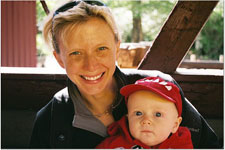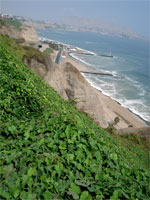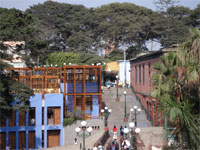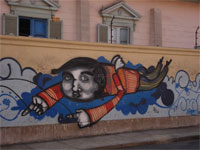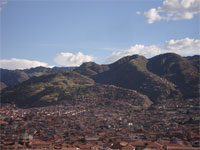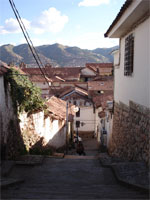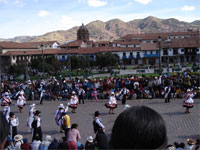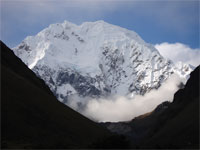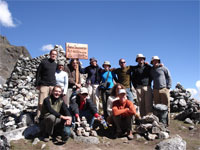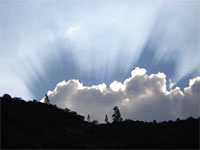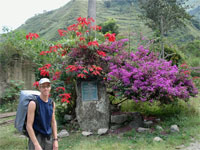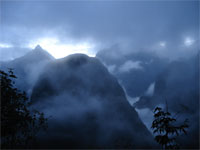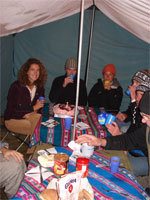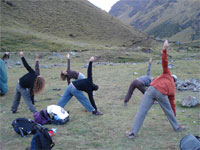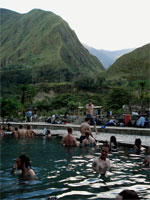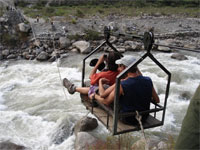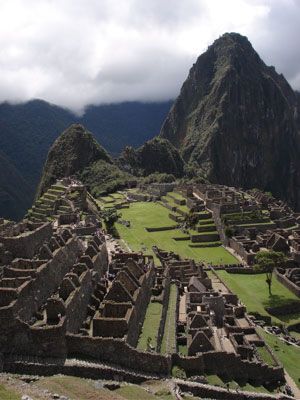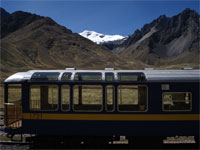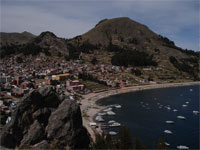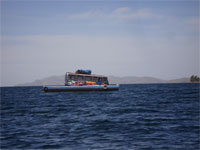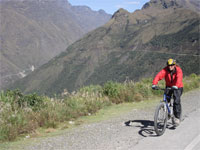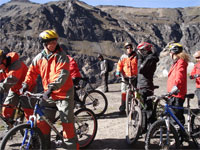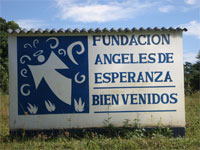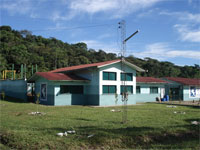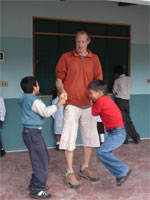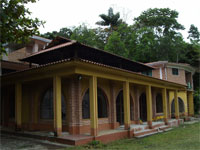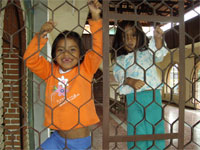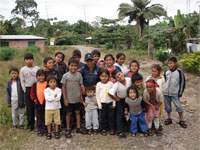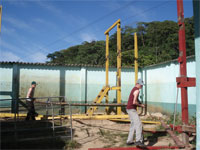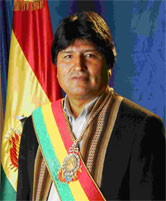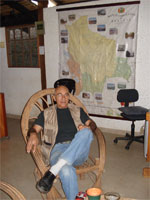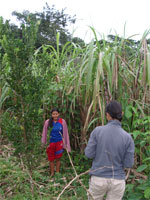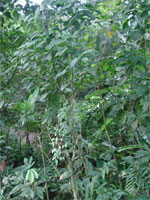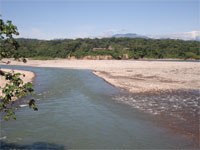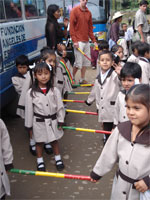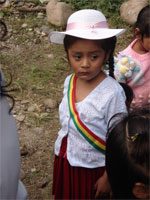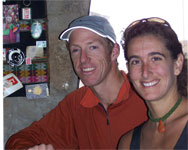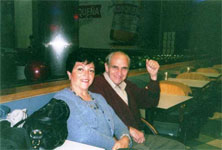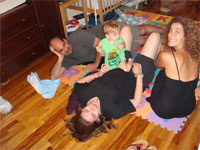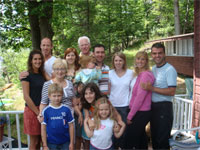South America
location: en route to Lima, Peru
date: 05/10/2007
Laura's thoughts: Perhaps some of you who have been checking our site regularly may have noticed that we have been remiss in adding new entries lately. Regrettably, this is due to an unforeseeable detour that we have taken because of a terrible tragedy which has occured to my best friend from Eastman. And because there will be no other way to explain the inevitable shifts in tone that I imagine our site may now take, I felt that I had to include this news on our site. On April 26, I got the saddest phone call of my life from Amy Jo Rhine (for those of you who may not know her personally, she is the beautiful blonde horn player who performed at my wedding and my festival every summer). She called to tell me that there had been a terrible accident in her driveway and her car hit and killed her precious 15-month old baby boy, Eliot. It is still too unimaginable to believe, as I write this, and my heart is breaking for her. And while she may be inconsolable at this point, I was only relieved to actually be on the continent so that I could fly to be with her right away.
Ironically, we had already changed our round-the-world ticket in February to spend a week in the States, en route from Japan to Lima, so that we could visit Michael (my partner with whom I run my music festival who was diagnosed with bone cancer in January). However, he’s been moved to Florida with his family, and he’s had an unfortunate post-operative return of his tumor, so he’s been re-hospitalized and we could not have seen him after all. So, instead, Geoff and I just spent a week with Amy, her husband Greg, and her 3 yr. old son in St. Louis. Our time with her and her family was simply the saddest thing that we ever witnessed. I can not imagine what they will have to endure to get through this tragedy. While they fortunately have Norty to bring them some semblance of happiness and purpose to cope with each day, there are also deeply painful moments of sobbing grief for them everyday. And staring into the emptiness of Amy's usually radiant, vibrant eyes was heart wrenching for me.
photo caption: Amy and Eliot; Greg with Norty and Eliot
Needless to say, this certainly changes our perspective dramatically for the remainder of our trip and, in some ways, it feels like an emotional point of no return in my life. While I have always known that many people in the world suffer great tragedies and shoulder incredible pain, such a cruel and horrific event happening to one of the people I love most in the world inevitably hit me much more viscerally. While I can not understand what she must be feeling, at times it seems like her pain is my own. This makes it hard to proceed with my life and our trip with any sense of normalcy. I wish that I could do more for her but I feel rather helpless. Even after a week of holding her hand, listening, and helping around the house, I am afraid that I have not even made a dent in her mountain of grief. Only time will tell.
So, although we have agreed that completing our intended journey is the appropriate choice for us at this point, it is with a heavy heart that we fly today to Peru. We know that we need to allow this tragic event to remind us to strengthen our resolve to Live Large while Life is Short, but right now our enthusiasm has dimmed. I hope that we will shift once we are there. And I believe that we may feel better once we are amidst the majesty of Machu Picchu and once we become involved in the volunteer work with children that we intend to pursue in Bolivia during our last month. However, I just don't know what to expect from the evolution of our emotions at this point.
And while many of our friends, this year, have shared their joys from new marriages, jobs, and births, too many others have also suffered great losses or illnesses (parents and life-long pets dying, and two more cancer diagnoses). Carrying our constant concern for Michael's health throughout our journey already weighed incredibly heavily on us while we were too far from him to help in anyway. And being distant from Amy while she walks this painful road will be even more difficult. So, we certainly hope that this is the very last tragic event to occur in the lives of those we love, especially while we can not comfort them in person. And we both hope that this message finds all of those reading it happy and healthy. Now, more than ever, we want to stay in close touch with the people we care about.
location: Cuzco, Peru
date: 05/13/2007
Laura's thoughts: Of course, it is taking some time to find our rhythm again as we return to travel mode. And while I intend to make the most of our South America experience, I know that I will continue to carry the weight of these recent circumstances for some time. I have been aware that the euphoria of India and Thailand could not last forever. However, unlike some people who pursue adventures like these to escape from reality, I always intended for this year to be an extension of my existence in all of its forms. So, I am trying to accept life's complicated fabric of experiences and flow with the myriad of emotions that are now arising. Fortunately, Geoff and I have developed a number of habits that help jumpstart the stimulation we so crave from travel. These include devouring maps, deciphiring transit systems, wandering urban green spaces and seeking out ideal cafe spots for people watching, reading or just day dreaming. All of these strategies help us remedy any disorientation that either culture shock or trip interruptions might bring. And, to varying degrees, they are making me remember why we chose to take this trip in the first place.
photo caption: Lima sights - cliffs of Miraflores; artsy Barranca neighborhood; vivid graffiti murals
Besides an insatiable curiosity for everything "other", what motivates me to explore the world is a strong fascination for the striking similarities that I am able to observe in otherwise disparate places. In fact, this same theme inspired my first CD, Echoes of a Blue Planet. For this project, I selected classical works influenced by various folk traditions because I wanted to demonstrate how people of many races and religions have found a common voice with which to interpret their world. Like the rhythmic patterns and scales that these pieces share, many aspects of each continent we have visited bare interesting resemblances to one another. And I find great solace in these echoed qualities because to me, it represents a unified human spirit which is expressed universally.
Most notable parallels have been those in the walled cities of Lucca, Italy; Essouiara, Morocco; Udaipur in Rajasthan, India; Chiang Mai, Thailand; and our present location of Cuzco, Peru (at the foot of the Andes where all Machu Picchu treks begin). Each was erected in the Medieval or Baroque period and they have all preserved their massive stonework remarkably well. Fully aware of their charm, they have capitalized on their tourist commodity with incredible skill, though, for the most part, they have managed to do so tastefully. In every city, one can find a tapas bar serving Mojitos and playing Chet Baker as easily as they can in Manhattan. And my aesthetic taste most appreciates how these cultures have fused contemporary design within their ancient walls. Of course, with every tourist destination also come the regrettable elements: cab driving vultures, the heightened threat of theft, and impossibly young children begging from the "haves". But we have come to expect these inevitabilities and have gradually learned to negotiate our way through these traps so as to truly enjoy the gems that these places have to offer. While I will always favor venturing off the beaten path, I can humbly confess to my continental tendencies and embrace these hot spots. And thank goodness each country still maintains a distinct flavor despite some of the sameness that globilization is bringing.
photo caption: 13,000 mountains surrounding Cuzco; steep cobblestone alleys; traditional dancers in Plaza des Armas
Unique to Peru and other South American regions is their famous coctail, the pisco sour (fermented grape brandy, egg whites and lemon juice), Alpaca wool, and to my great chagrin, the ubiquitous panpipes. Though a pale cousin to my own instrument, these bamboo flutes have been bastardized by Zanfir and innumerable street musicians worldwide. Having busked for years during my university days, the incessant whining of these Peruvian ensembles - who always manage to find the most visible corner in every city, drowning out the possibility for any other street performers to play within a 500 meter radius - has become akin, in my mind, to the sound of a dentist's drill (no offense, Dad). However, because I love being in a nation which encourages public affection, favors bodacious curves over waifish figures (even in their manikans) and truly know how to fiesta, I can easily tolerate this mild annoyance.
location: Machu Picchu, Peru
date: 05/20/2007
Geoff: We are back in Cuzco, the capital of the Incan Empire, enjoying the afterglow of a 5-day trek to Machu Picchu. Being at the last-minute, end of the trip, planning spectrum, we had not made the necessary 6-months-in-advance reservation to hike the classic Inca Trail. Instead, we hiked one of the many "alternative" routes that are now offered to fill the spontaneous travel niche. In all fairness, they provide a completely different experience that, while lacking some of the cache and archaelogical highlights of the Inca Trail, offer more varied terrain and some solitude. The daily quota of trekkers is 500 on the Inca Trail; our route had about 40 people spread along it each day. We heard about the option from some friends as well as the Sunday New York Times Travel Section, which coincidentally has featured interesting articles on about 10 of the places that we have visited this year and has proven quite helpful.
Our trek took us out of the jungle, into the high passes next to Salkantay Peak, which were out of this world. Salkantay is at 6271m (21,000ft), the highest mountain that either of us had ever seen, and the hike up to the pass, at over 15,000 feet, made us feel like we had earned the views. We only had to carry day bags for the first three days as our trek included donkey support for the equipment, so we appreciated the lightness. At first, we were a little concerned that our group included 12 people of varied ages and backgrounds, which had the potential for pace disaster and awkwardness, but we completely lucked out. The group not only kept a pretty consistent speed the whole way, but we got along like a family which added a joyful comraderie that was unanticipated. We clicked so well that we even went out for a feast when we returned to Cuzco, last night, after the tour had disbanded. I love to meet interesting new people, but I think that Laura especially enjoyed the infinite, new conversational opportunities that don't exactly jump out at you when it's just the two of you, 10 months into a 24/7 trip. It proved to us that with a little, or possibly a huge amount of luck, small esoteric tours can attract really cool people.
photo caption: 21,000 ft. Salkantay Peak; Humanitarian Pass; our tour group at the highest point on the trek (4,600 m/15,400 for the Americans reading)
Anyway, the trekking experience included some of the most intensely rewarding experiences of the year. The mountains here are green, steep, and varied, unlike anything I have seen before. The rainy season ended a couple of weeks ago, so the rivers were raging and the vegetation was exploding as well - take a look at the pointsettia trees below, just a distant relation to the 6 dollar, 8-inch varieties that we buy at Safeway in December. Machu Picchu was the neon goal at the end of the journey, but it never felt that we were putting in time until we got there.
Travelling has made it difficult to stay in prime shape, but 5 days of predawn starts and 5-8 hours of daily hiking brought welcomed soreness and endorphins back to the body. By day five, when we started hiking at 5AM, we were pretty much in the groove. We left the touristy base town of Aqua Calientes early, to ensure that we would reach the highpoint of the actual Machu Picchu site when the sun crests the neighboring peaks at about 7 AM, spotlighting the ruins. As like most of the pictures we had seen of the site beforehand, the morning was shrouded with misty clouds, which, to us, only added to the experience.
photo caption: insane sky; pointsettias on steroids; misty hills on our pre-dawn hike
Laura's thoughts : With Machu Picchu as its zenith, one could not ask for a better birthday week. But as stunning as was the goal, the approach was hardly lacking for drama. As seen from above, the views over Humanitarian Pass, along our Salkantay trek, may have provided the best photos of our entire year. And having learned that we are quite wanting for more photographic expertise, we always appreciate a little help from Mother Nature and the ideal lighting she set up for us here. The most memorable moments of our week were the Dutch Oven surprise birthday cake that our guides prepared for me - like all food eaten while camping in the wilds, sponge cake and eggwhite frosting never tasted so good; sunset yoga which I led with our trek group each night; the Santa Theresa hotsprings; and a cable car ride across a raging river. But I also realize that each of these moments were savored all the more because of the anticipation that was building as we came closer to the Legend.
photo caption: birthday cake; yoga; hotsprings; cable car
Rarely does a place live up to one's expectations when it has been forever built up to the mythical proportions that Machu Picchu has, but it truly did. Completely surrounded by verdant, triangular peaks, Machu Picchu creates both a dream-like visual as well as a powerful energy that I felt, quite literally, when our guide asked us to let our hands hover only one inch above the massive rock at the center of the Incan Sun Temple. Also, the physical satisfaction of having reached there on foot, after 64 kilometers of trekking, only added to the sense that all of my life's events have propelled me towards this magical moment. The random set of circumstances that have connected my life with Geoff's, years of flute training which have enabled me to acquire a good job, purchase and then sell a home to finance this trip that we have so mutually desired, and a lifetime of nurtured passion for the outdoors and exercise seem to have conspired to place me in front of this world wonder. I was overwhelmed by my fortune to be there, but also by the realization, in light of the sadness that I am still carrying for Michael, Amy and Greg, that life can be, at once, brutal and amazing.
photo caption: Machu Picchu finally revealing itself in all its glory thorugh the mist
location: Copacabana, Bolivia
date: 05/23/2007
Laura's thoughts: On such a long trip, I feel that I can truly lose sight of the exoticsm of my daily life. In fact, to de-glamourize travel for just a moment, some days it simply feels that finding a room, purchasing my bus ticket to the next destination, packing and unpacking is my job. But when I verbalize the reality of our current situation outloud, I can not help but remember how "other" our current existence really is: "After trekking to Machu Picchu, I am stuck in Lake Titicaca waiting for the Bolivian bus strike to lift, so that I can make my way to Copacabana". I can't say that everyday!!
photo caption: train to Lake Titicaca; Copacabana; floating bus out of Copacabana once strike was lifted
location: La Paz, Bolivia
date: 05/25/2007
Laura's thoughts: All year, as I have recorded my experiences on this site, I have attempted to maintain a delicate balance between overpersonalizing or underrepresenting my travels. Also, having read many previous travelogues which too frequently resort to sardonic humor as they express a myriad of complaints about foreign cultures, I have sought to avoid sounding like sour grapes no matter how challenging our circumstances have become. And, in sensitivity to the realities of our readers who may not find daily life as exciting as a trip around the world, I have also attempted never to appear as if I am flaunting the grandeur of our life on the road in any way. Reconciling all of these factors, as optimists by nature, I think that Geoff and I have chosen to keep a generally positive tone, exempting, of course, the very recent sad news about our friends. However, with a few beers in me, a massive head cold that I have not been able to shake for 10 days, and the overall weariness that 11 months of travel brings, I can not help but spend these next few paragraphs kvetching.
As I sit on my separate twin bed, in what definitely qualifies as one of the 3 worst hostels of our year, cringing at the smell of raw sewage wafting from our toilet (only slightly dampened by my stuffy nose), I am wondering exactly what prompted me to sell my spacious, modern townhouse and quit my cushy job to put myself in this position. It seems that all of the systems which have allowed our trip to proceed like clockwork, until now, are suddenly breaking down. Having taken all of the necessary precautions to avoid theft (after the shocking robbery of Geoff's prized mountain bike in Vancouver just before we left), we had managed to hold on to all of our other possessions until now. Yet, in only one week, my Smith sunglasses were stolen on our MachuPicchu trek, border police slipped a $20 out of our wallet during their rigorous inspection upon exiting Peru, and our thumbdrive, which held all of our backup files and photos, mysteriously slipped out of Geoff's pocket only yesterday. Then, to boot, today my only sandals broke as I trudged up the arduous hills of La Paz. So, I was left barefoot, climbing their filthy cobblestone, at 12,000 feet above sea level, in a nearly fruitless search for replacement footwear. Add to this the fact that my server is down again, preventing me from accessing my email, and we learned that we will need to take a 24-hour bus ride back to Lima after our volunteer project ends, in order to catch our flight home, and you have me pretty much at my whit's end. Small problems, I know, but their accumulative effect has currently created what seems to be an insurmountable irritablility.
So, as it appears that a dim cloud is currently hanging over our heads, I can not imagine a better remedy than to voluntarily join a mountain biking tour which, tomorrow, will desend the 64 kilometers and 11,000 feet of Bolivia's infamous Death Road! Sounds like a wise idea for two people who are feeling particularly lucky right now. So, when and if we return alive, I'll let you know if this adrenline rush cleared all the bile and venom out of my system.
photo caption: steep streets of La Paz; Death Rd. (deceptively flat as pictured here) - WE DID SURVIVE AND I AM, INDEED, CLEANSED!
location: Coroico, Bolivia
date: 05/26/2007
Geoff: Today we "survived" the Death Road Mountain Bike Adventure- as it is self-described. Like bungee jumping in New Zealand, this is one of the posterboy adventures on the South American tourist circuit. As cyclists, we could not resist. The Death Road is so named because of the average of 24 people who, each year, lost their lives in one of the numerous vehicles that plunged off the narrow, cliff-side road. The mountain bike tours have been operating for the past decade, appealing to the desire of every youngish tourist, to indulge the impulses of their testosterone stores. In reality, the decent is technically quite tame, but so beautiful that it is difficult to keep your eyes on the road for what may be the longest sustained road decent in the world: 12,000 feet in 64 km. Just recently, all of the motorized vehicles were diverted to a new road that climbs up adjacent ridges and faces for most of the distance. This means that for the last 40 km, the added risk of being hit by a climbing Mack truck coming around blind corners on a single lane gravel road is eliminated. So, for the most part, casualties are now averted, though the street talk claims that 11 cyclists have plunged to their death. (5 of the 11, apparently, were Israelis. Many of the Israeli tourists are traveling after surving their 3-year mandatory military service, so it seems especially unlucky to die mtn biking. The one Israeli, in our group of eight, was well aware of the proported stats, and wisely showed extreme caution in taking up the rear. ) If the stats are true, I think that most of the accidents are probably a result of the fact that the vast majority of participants have no mtn bike experience, and just get in over their heads in a setting that offers no forgiveness. Add to that recipe the use of nice downhill full-suspension rigs by several of the companies, and it is like handing the keys of a new Porsche to a 15-year old boy who has just finished off 2 litres of coke and the lastest Fast and Furious movie - in North America, the legal liability would shut this thing down in a second. In Bolivia, we didn't even sign a waiver.
Laura ripped it up and let it fly all day long, after claiming for days that she was sure she would be el slowpoco. We thought the downhill, full suspension mountain bike option was overkill (and too expensive), but we did take the extra precaution of renting bikes with good hydraulic brakes. The ride starts at an elevation of 15,600 feet and the two early, and only, quick climbs let you know what your heart sounds like. After that phase, it was pure pleasure. The two guides clearly wanted to minimize the injuries by setting a reasonable pace, and telling us that they never let their clients go too fast. But, after a casual chat, a couple of hours in, Laura happened to tell one of the guides about my mountain biking background, and I swear that Julio spent the remainder of the day trying to drop me. Fortunately, most of the group took up the chase with gusto. We would stop briefly, every 10 or 15 minutes, to regroup and take off another layer of clothing (it was about 35 F at the top and 85 F at the bottom in the jungle). The stops forced to you to remember to look around and soak up the grandeur, leting the guides complete their template of group action shots that they then gave you on CD at the end - they have the tourist package down pat here. So, after 5 hours of vertigo-inducing views, we finished up with a hot shower, buffet lunch, patio view of the whole ride, and, oh ya... a 3.5 hour return drive to La Paz. (It had been only 45 minutes to drive to the departure point in the morning.) The return trip flew by in great conversations with our typically diverse cadre of German, Brit, and Israeli travellers, who all retired to a great bar/restaurant back in La Paz for tasty microbrews. Because it had been almost a year since my last long epic biking day, I especially savoured the familiarity of the structure, yet the exoticism of the location. So, pretending this is an actual review, I recommend it heartily to all who visit Bolivia someday yet typically avoid structured tours. (If I am ever back here, I have promised myself to try and climb up the thing - a lofty goal since it would be the equivalent of 6 back-to-back AZ Snowbowl climbs, but on dirt, and at high-altitude. I think I would need something even stronger than the coca leaves, constantly chewed by locals.)
photo caption: Death Rd. start at a breathtaking 15,600 feet; incredible view of the Cordillera Real range along the way
location: Villa Tunari, Bolivia
date: 05/30/2007
Laura's thoughts: All year, we have searched for the opportunity to give back to a community in at least one of the developing countries whose resources and people we have so enjoyed during our trip. And finally that chance has presented itself to us. Here, in Villa Tunari, Bolivia, Project Angels of Hope has recently developed a volunteer arm to support a preschool and medical clinic, established by a US-run Foundation in 1998, to serve the families of the Chapare region, home to some of the poorest people in South America. The locals moved here from more urban areas, only about 50 years ago, with the promise of prosperous agricultural land which was especially ripe for coca farming. Unfortunately, this meant massive deforestation of the dense jungle here. As well, these farmers have now been mostly stripped of their livelihood due to US-imposed drug policies eradicating coca production because of its frequent use for cocaine. Of course, coca leaves have been used for centuries in Bolivia to improve mental clarity, stimulate the nervous system, suppress the appetite, and fight altitude sickness. And, for decades, it has provided an essential cash crop for thousands of Bolivians, but this was obviously no concern of our government. So, many of these families have been left destitute and this foundation is greatly helping their plight.
In addition to the school and clinic, the Project has started a latrine building effort in conjunction with health education. Geoff and I are helping, in particular, by putting our non-profit fundraising experience to use as we research corporate sponsorships for free soap and toilet paper as well as other various funding mechanisms which can provide financial resources for a handwashing promotion campaign. We are also able to get our own hands dirty washing dishes for school lunch, painting murals in the cafeteria, and pushing dirt to improve the school bus driveway. However, the volunteer coordinator primarily feels that our skills can be best used to ensure the long-term success of their NGO. So, ironically, we are spending most of our time in the Bolivian jungle at an internet cafe with speed comprable to mid-90's dial-up service.
photo caption: Project Angels of Hope school building; Irida & Nida, POAH kids climbing the Geoff tree, as usual
We have assumed another responsibility which includes marketing POAH's community service efforts through various travel websites so that they can more consistently maintain their capacity of 12+ volunteers. Currently, they have an influx of anywhere from 2-15 helpers in residence at any one time, yet this program has the potential to attract much greater numbers. In our extensive research for an appropriate service project, we were dismayed to learn about the preponderance of "volunteer vacations" which seem to be exploiting both volunteers and communities by charging exorbidant fees to administer service/tour experiences. Also, few NGO's are looking for short term help. However, POAH only requires a 2-week stay, charges only $75 per week for decent dorm accomodations (and $50 for each week after that), and offers 2 hours of daily Spanish instruction for free. Certainly, we are reticent to confuse our brain's already jumbled language compartment, having only just touched the surface of French. However, we are finding that our recent language training, almost identical grammar to French, much shared vocabulary with English, and remnants of Sesame Street knowledge are making it fun and easy to pick up a bit of a third language.
Anyway, in case any of you want to help spread the word or lend a hand yourselves, please direct people to:
Projectangelsofhope.org
photo caption: the Castillo - volunteer housing; our new housemates, Irida & Nida, daughters of the PAOH handyman & students at the school we serve
location: Villa Tunari, Bolivia
date: 06/03/2007
Laura's thoughts: Now that we have settled down a bit, without some of the frills and thrills that Machu Picchu and the likes offered, I am coming to terms with reality again. Firstly, in light of our concerns for Michael and Amy, our website heading, "Sans Souci" (no worries) has felt far less appropriate. Then, this has been made even more true as we have gained an informed perspective about the struggles of these Bolivian communities. But what is most ironic is the fact that while we are finally in a position to offer our generosity abroad, I feel much less emotionally available to do so than I normally would. So, although I recognize that these beautiful Bolivian people need humanitarian aid to empower them to help themselves, I am left conflicted, wondering if my energy could be better spent helping those I love at home, right now. The volunteer spirit was born in me very young. At age 12, one of my school mates was killed by a car while riding her bicycle, and I ran a weekend fair to help raise money for the scholarship that was established in her honor. I have always derived a great amount of satisfaction from helping others, fully recognizing the selfish motives behind my "selfless" work. But as I have shifted from rape crisis phone lines, to hospice care, to bicycle advocacy, I have spent a good deal of time considering where it was best to channel my efforts. And while the allure of helping extremely poor communities, living in exotic lands, was always there, deep down I wondered if the problems in my own backyard were perhaps the most valuble place to serve.
photo caption: Smiling Chapare kids sporting new sandals; school playground BEFORE & AFTER
For years, I have pondered the question of how one can best offer assistance to a culture that is not one's own. After 9/11, in Afghanistan, US military dropped 1,000's of yellow food packets full of peanut butter (an item totally out of keeping with their diet) in areas where several dangerous land mines (also yellow in color) were already located. Therefore, people were either terribly at risk or too frightened to even collect the aid. This is only one striking example of uninformed, innappropiate aid that has previously been brought to my attention, and I kept it in mind as we explored options for service abroad. Now that we are actually involved in the work firsthand, I have a bit more empathy in regards to how easily good intentions can go astray. Last week, for only $100, 100 pairs of Teva-knockoff sandals were purchased and distributed here in the Chapare region. This was done in an effort to help the Foundation's children avoid ringworm and fungus. However, two days after they were delivered to families, smiling ear-to-ear, at least a dozen pairs' velcro straps had already failed. I guess you get what you pay for. And now Geoff will spend next week helping to tear down a wooden playstructure that was built and reconstructed, several times by previous volunteers, but can not withstand the wet summers here without rotting dangerously. Hopefully, I will succeed in finding sponsorship from a recycled plastics distributor to rebuild a more sustainable playground for the Foundation kids in the near future. But, as with most non-profit work, extremely limited resources and staffing makes the most earnest of intentions often impossible to realize. That said, Project Angels of Hope has accomplished incredible things in the past 9 years, though it seems that even the most successful NGO's are fraught with difficulties.
At any rate, the ideallic days of basking on a Thai beach are behind us, and harsher realities about both the Third World and our world at home are before us. I only hope that some of the enlightment we gained in India, and a bit of the unfettered mind that we developed in Thailand will provide us useful tools for facing these challenges.
location: Villa Tunari, Bolivia
date: 06/06/2007
Geoff: One of the great things about volunteering in a foreign country is that it is an excellent way to learn a lot about a region; in this case, especially the culture, economy, and history. Today, we got a graduate seminar semester worth of background from a local CHARACTER, Rodrigo. This loquacious expert is in his early sixties and has retired back to Bolivia after living and working around the world for most of his life. His father was a diplomat, posted in numerous countries, which paved the way to Rodrigo learning 8 languages and developing a very sophisticated world view. We spent 15 hours with him on our one day tour and he was able to talk, non-stop, for about 14 of those hours on Bolivia's place in the world.
As a result we now have a better feel for at least the rudimentary basics of how it came to be this way, and where it might be going. Some of the most interesting points that we feel are essential to this place include the following:
The election of Evo Morales, in 2005, was a first for a candidate of indigenous origins in all of South America, and it has ingnited a maelstrom politically. The vast majority of the population is of Indian or mixed race, yet has never been able to vote as a block, and now many of the residents, who identify themselves as "white", are seeing their preferred status challenged. This translates to issues such as land reform where white owners, having controlled vast tracts of lands allotted or afforded to them through shady government loans, are finding their properties usurped. Other territorial concerns involve claims of huge gas stores, near Bolivia's eastern border, as well 40% of the world's steel reserve (in the form of iron and magnesium) on which Brazil has set their heights. Chile also has designs on some of Bolivia's water supply for mining. So, Morales has a precarious job ahead negotiating with his neighbors while trying to protect his land.
photo caption: Rodrigo; Evo Morales, Bolivia's new indigenous President
Morales has also made big waves in the US by refusing to eradicate the growth of coca on the basis that it is a historical way of life for his people. This edict does not include cocaine use, but rather the use of the leaves for tea or chewing. You see male workers everywhere with huge wads in their cheeks that provide many benefits (which Laura already mentioned) to help them endure their gruelling work days. However, the US likes to cut off cocaine production at its source, through many heavy-handed and sometimes nefarious methods. In fact, we are staying in an old hotel directly across from a permanent narcotics screening by a special military force that is financed by the US government. (Funny, you don't see the US government eradicating the Swedish grain crops because they are sometimes used to make the vodka that feeds the addiction of American citizens...hmmm?) To complicate matters more, Rodrigo, of mixed Indian-Spanish blood, told us that the historical claim for Indian use of coca is almost a complete fabrication, as it was used only minutely by royals and during festivals prior to the Spanish conquest in the 1500's. In fact, the Spanish encouraged the growth and use of coca because the peasants could work harder to the benefit their Spanish masters. So, in another light, it is a symbol of the colonial oppression.
Much like apartheid in South Africa, the institutional effects of almost 500 years of colonization are apparent everywhere and reinforce the economic divide. The was first instigated by the Spanish, and then, after the Simon Bolivar-led ousting of the Spaniards in the early 19th Century, by the Mezistos. The rural cities, towns, and regions have almost no tax base and lack the infrastructure and tools to remedy this situation. When people find out what my area of work is, they uniformly bemoan the lack of planning that stymies their hard efforts to improve their economic and social conditions. Two examples provide a picture:
Rodrigo showed us a beautiful banana farm in one of the poorest rural areas. The farm was to be an example of how to properly grown bananas for export - as an alternative to their goldmine export: cocaine. The EU sunk $30,000 into this farm, which is a fortune here and is magnified by the low cost of things in Bolivia. This money also went towards the capital equipment for properly bagging and mechanically harvesting the banana bunches so that the product would be acceptable for international markets. The EU brought in all the experts, and highly publicized the project as the panacae for former cocaine farmers. The end product is great, but this area is way too remote, via all transportation modes, to reach any of those markets in a timely manner. Furthermore, the EU has exclusive contracts with other former colonial nations for supply, and everyone else in South America has their own production. So, these farmers (campeselos) are left to sell only to locals at the ridiulous price of a mere $2-3 per 750 bananas!
photo caption:sugar cane farm, another unexported alternative crop to coca; second growth Amazon basin jungle; ever-changing Santa Espirtu River
The town of Villa Tunari is beautifully situated on the edge of the Amazonian jungle, between two rivers, adjacent to the Andean mountains, and on the road between the major urban cities of La Paz, Cochabamba, and Santa Cruz. Quite correctly, many thought this would be a good place to develop tourism- mainly domestic, but also some foreign. However no community plan exists leading to many horrors:
A town of 2,500 has 61 hotels scattered all over the place. Most are almost always empty and create black voids. Some of the hotels and buidlings were placed on riverside properties that are now the property of the river. The river changes directions all the time and has recently begun to attack the town sides, taking 200 metres and several cabins in the last couple of months alone. This is further exacerbated by property owners that cut down embankment foliage for views, speeding up erosion.
The jungle that they are selling to tourists has been ravaged over the last 50 years, leaving less diverse second growth and working fields. The animals that people want to see have subsequently taken off. And the river, seen as a free playground for tourists, is heavily polluted by the raw sewage drainages of the town as well as the chemical run-off from cocaine production. All told, it is extremely maddening that people with admirable objectives and excellent work ethics are left to toil. But, they toil happily.
It is this apparent contentment with so little that continues to affront us as we travel through developing countries. People with hardly a roof over their heads smile throughout their days; children find hours of fun and laughter using a dilapated plastic cushion as a boat that they can slide around a concrete floor; and families who struggle to feed themselves are eager to share fruits from their farm with foreigners lending a hand. It is trite to reiterate the excesiveness of our material needs in North America, but sometimes the obvious must be stated. I just hope that we can maintain our vow to live more simply upon our return, once we are again faced with all of the temptations we find at home.
location: Villa Tunari, Bolivia
date: 06/08/2007
Laura's thoughts: As our time here has progressed, so has my confidence that we ARE making a difference, however small. Witnessing some of the students going home to shelters without fully enclosed walls, in a region that gets nearly 6 meters of rain per year, I am more aware of the value and necessity of services that this institution is providing. At the Angeles de Esperanza school and health clinic, kids receive a sound education, led by caring Bolivians, in an attractive environment, as well as two well-balanced meals per day. And the Project does not only offer hope to these families - it builds communities: amongst the students who are gathered by bus from 4 different towns in the area; amongst the teachers and doctors who live together at the school, Sunday - Friday evening, until they return to their families in Cochabamba (a city 3 hours away) for the weekend; & amongst the volunteers.
Though only temporary, our extended stay in Villa Tunari has reminded me of how much richer travel becomes when you take the time to stop somewhere long enough to truly interact with local people. Our tour with Rodrigo did not bear any resemblance to some of the Gringo Trail excursions that we had taken, previously, for lack of any alternative ways to see indigenous culture. For example, the "not to miss" floating islands of Lake Titicaca were fascinating to see; however, their authenticity was compromised when we later learned that the Amarya people have only sustained this unique way of life as a tourist attraction. This harkens back to visions from my youth of the re-enacted colonial villages at Plymouth Rock.
photo caption: REAL sparse living quarters of a Chapare farmer; ENHANCED homes, built only from reeds, on the floating islands of Lake Titicaca
With our more genuine glimpse of Central Bolivia, I can now tie together a number of observations that I have made in developing nations throughout our trip. Firstly, people of lesser financial means work incredibly hard...almost everywhere (India, Thailand, & Peru included). And I have come to see them not as owning fewer material goods, but rather as possessing an abundance of resilience and resourcefulness - qualities that North Americans could do well to adopt. While I can come up with no more than three recipes that I am able to create with the 20 basic ingredients available here, I have not seen our Volunteer Director's Bolivian girlfriend repeat a meal she's cooked during our entire two weeks. And since the bikes ridden by locals and the cars driven by cabbies (the only auto owners in the area) are nearly 30 years old, Bolivians have all become expert mechanics and take great pride in keeping their vehicles running strong.
I have also noticed that hard working nations find any excuse for a holiday in order to get a well-needed respite from their toil. If each bead was a different festival (Hindu, Christian or Muslim), India would be a beautiful necklace spanning a meter. Thailand loves holidays so much, they make them last 5 days long (ie. Songkran). And Bolivia enjoys its fiestas as much as any Latin American country I've seen. Since May 24, we've experienced four legal bank holidays here: Teacher's Day, Corpus Christi, Villa Tunari's Anniversary, & Dias del Mamas. And in this typically Catholic country, who praises Mary above Jesus, Mom's rule. So, new florist stands abounded just for the occassion, while every adult son carried a freshly baked cake to his childhood home, and every daughter busily prepared an elaborate meal. Not to mention the fact that every hooligan in town used Mother's Day merely as an excuse to binge drink - after all it IS a holiday.
Anyway, a week that began escorting wide-eyed kids in traditional dress for their Anniversary Parade, and ended with the completion of our World Map mural on their school cafeteria wall, is one that we'll never forget.
photo caption: PAOH students in Villa Tunari Anniversary Parade; pensive gaze of the 3-going-on-83 year old Parade Princess; our world map wall mural
location: La Paz, Bolivia
date: 06/12/2007
(Note: more photos to follow, since our camera was stolen by a slasher in La Paz and we have only disposible camera prints that we have yet to scan and include)
Laura's thoughts: Well, after a nearly disastrous farewell meal that I cooked for 14 volunteers residing at the Castillo, we started the final leg of our journey. (note to self: just because tin cans have red wrappers with pictures of tomatoes on them does not mean that I should buy 12 of them to prepare my family's secret marinara recipe, because they might actually be cans of sardines!). So, the first 10 of 40 hours of bus rides, which will take us to Lima for our North American departure, were relatively uneventful. And though we stopped over for one more day in La Paz, with only a little trepidation due to our harrowing last day there, we looked forward to returning to some urban comforts - not the least of which included lattes & wheat beer. Little did we know that both more & less pleasurable realities awaited us. To start, I woke up in this mile-and-a-half high city with my first-ever bloody nose. Then, after a successful morning, shopping its vertical streets for handmade gifts to give our families and friends, we lunched at our new home-away-from-home: Alliance Francaise. We have come to adore this institution for its consistent contribution to the cultural life of hundreds of cities around the world. Like many we've visited this year, the center in La Paz houses a cutting-edge gallery, a trendy french cafe, and hosts ecclectic music and dance events every week.
It was at Le Bistrot that we began our string of chance encounters with fascinating strangers. Luis, a former KFC franchisor for South America, used his affluence to transport, house, and school several children from remote jungle regions of Bolivia, who otherwise had no access to an education. Interestingly, he enlightened us to his progressive political views for an hour as we observed one of Bolivia's nearly daily street demonstrations, this time calling for better workers' pensions. It has been inspiring to watch true democracy in action here. Anyway, this engaging meeting followed an equally intriguing one only the previous night. In a nearly deserted bar in Villa Tunari, we happened upon two Italians who are creating a National Geographic feature and documentary exposing the coca quagmire in Bolivia. Always a glutton for conspiracy theory, I was keen to learn that Coca-Cola is the only corporation anymore allowed by the US to import coca, and the benefits of this extend well beyond the production of the world's beloved soft drink. The alkaloide which must be extracted from the coca leaf, to create Coke's great taste, is being purchased by huge pharmaceuticals to manufacture cocaine! How do you spell complicity? - CIA. And, as if this was not juicy enough, Sebastiano, had also been the founder of one of the most coveted URL's in the world: hell.com (still for sale for the meager price of $1.5 million). A members-only parallel web for multi-media designers, this site was hit (though not entered) by millions of people a day, until it went down with the dot.com crash in 2000.
The next stranger to grace us with his presence was Guillarmo, the 70 yr.old fascist Bolivian sailor that we met grabbing an afternoon coffee. Unfortunately, his diatribe against everything, from Castro to the Chinese overtaking Vancouver, distracted us from our only true robbery of the trip. Somehow, just after our conversation, a thief managed to cut my camera strap right off my wrist, without me even seeing. And its replacement will be the third digital camera that we have purchased for the trip, since our first one broke in Paris. Ironically, La Paz being nearly a police state, with law enforcement officials donning pepper spray, billie clubs, and riot shields on every corner, does nothing to dissuade tourist theft. Though a temporary bummer, recent life changing events have certainly helped us keep perspective on the impermanence of things, making it easier not to cry over spilt milk. So, we merely added this to the plethora of digital disasters that have befallen us throughout our 21st-century, well-wired tour. Just to recap, our Mac battery died in Copenhagen, its plug burned out in Morroco, then we left the new one in Hokkeido. We lost our itunes library for a month in India, and three years of iphoto files in Thailand (both of which were eventually recovered). Lastly, our web server went bankrupt without notifying us, so our site and email was down for a few weeks in South America. But, Thomas the Finnisher saved the day, and we are now up and running with a new server. So, all is well in cyberspace.
location: Colca Canyon, Peru
date: 06/18/2007
photo caption: Welcomed taste of home: See PT on the left side of the photo?
Geoff: Today we finished a quick two-day exploration of a canyon that Peruvians claim is the deepest in the world. At some points the walls from the river rise over 3,000 metres. We explored a more open point that only drops less than half that vertical, but through some stunning landscapes. The riverside huts also have the added glory of warm spring-fed pools to soak the sore muscles. It is hard not to make comparisons to the Grand Canyon experience, since we have spent so much time there. On the plusses side, we barely saw a soul while hiking on either day, and the fact that the canyon is peppered with towns and villages that farm the terraced hillsides and flats makes one's jaw drop in the face of that kind of tenacity- no John Deere tractors in this landscape. In fact, one of the villages provided one of the strongest "small world" moments of the whole trip. After hiking back up to the rim, we wandered into a small back alley cafe for some sustenance, sat down at one the tables, looked up at the bulletin board on our wall and were greeted by a still smiling Pete face on a Pay'n Take decal. For you non-Flagstaffians, Pay'n Take is our 400 square foot bar/convenience store/cafe that also acts as the nexus of the outdoor community in Flagstaff. We speculate that it must be the work of Steve and Denise Garro and Joe Murray who visisted the area several years ago. Steve even presented a slide show on the trip several years ago at our mountain film festival, but I must have missed that section while attending to organizer duty, which added to the surprise.
location: Arequipa, Peru
date: 06/20/2007
Geoff: We almost didn't make it here, to the "White City", so named because of the predominant use of white Silba stone in the architecture for the last three centuries. We have been around the city for almost a week and it is one of the favorites of our trip. It has a bit of everything: gorgeous colonial architecture, the grandest central plaza we have seen all year, great restaurants, endless sunshine, and 6,000 metre mountains. Arequipa is generally a prosperous middle class city. We have had the discussion with other travellers that this type of city does not fit their South American expectations and thus is somehow deficient because it is more Western. But for us, we love to see how people are really living and what they are aspiring to achieve. Sure, they might not feel exotic and the differences between here and home are subtler, but including adding these environments to the trip itinerary ensures a wider view and makes sure that you are not simply on a poverty theme tour. One also sees how government policy and politics work in living colour.
During our time here, we have witnessed protests/parades daily through the main streets downtown. They have got this thing down, with great signs, huge flags, and brass marching bands. Rarely did we know what exactly the groups were grieving against, but we loved the festivity. Things turned a little hairier today when the town shut down due to the public transit strike and we had to make our way to the airport, 10km outside of town. When they strike, they barricade many streets with rocks, flags, barriers,and people, effectively reducing 99.99% of the vehicle traffic. 6,000 government troops and police were on duty to deter violence. Our hotel assured us they could get us there within a small unmarked car in the afternoon and what followed was a little taste of Bourne Identity-like driving. Our guy whipped in and out of alleys for 45 minutes, pulling U-turns at the site of angry protesters, driving on sidewalks and lawns, around strewn glass and boulders, all the while ignoring refrains of disdain from passerbys. Our driver seemed completely unfazed by the whole thing. I found the trip facinating due to the extremity of the passion exhibited relating to buses, but I also felta little guilty for betraying my public transit lineage by crossing the lines.
location: Chorillos, Peru
date: 06/22/2007
photo caption: Mery and Enrique, our Lima Servas hosts
Laura's thoughts: There's nothing I like more than a good palindrome, and our last days in South America offered us exactly that. If was befitting that an epic which began by staying with Servas hosts, would end in an identical fashion. Like Marianne and Gregers in Copenhagen, Mery and Enrique shared our parents' age, youthful spirit and infinite generosity. We arrived at their home, in the beautiful seaside Lima neighborhood of Chorillos, on Wednesday afternoon, and by Friday morning we were exchanging music collections, cocktail recipes, and photo albums. As with each of our hosts, we became like family in a matter of days. I can not explain how touched I have been by the recognition that during this time in history, when the media's coverage of international terrorism manufactures so much fear of Otherness, there still exist people throughout the world who will immediately open their hearts and homes to strangers. Servas was founded on this truth which is far more pervasive than that which reports the rare cruelties perpetrated in the name of hate. This peace advocacy organization established an international network of host families, just after World War II, in an effort to cultivate understanding between disparate cultures. Thus far, our experiences with a dozen members, from 6 countries, certainly affirms their success. And while I am reticent to spread their gospel too far, for fear of spoiling a well-kept secret, it would be against their open nature to withhold my praise.
Having just parted with our hosts, we have now reached the airport for our last foreign departure of the year, and I find myself in a very fertile state of mind. Emotionally, I have pangs reminiscent of the end of a long, ecstatic, summer camp. At the same time, this melancholy is mixed with Christmas Eve-like anticipation to see family and friends. Amidst this teeter-totter of feelings, I am pondering what I will miss once the trip is over and also what I can not wait to return to.
What I'll miss:
being surrounded by foreign languages
the mental space to always follow my intuition
constant new stimuli
writing this website
$6 massages
laundry service
no bills to pay
waking to rooster calls
What I'm looking forward to:
being able to flush paper down the toilet
drinking tap water
eating raw food
npr
trader joe's
my cruiser
new belgium beer
performing
a closet
tennis
non-smoking environments
david letterman
location: New York, New York
date: 06/26/2007
photo caption: It's great to be home: our nephew Miles Dylan Barron (destined for musical fame with a name like that!) & family; huge Cross clan of 13
Laura's final thoughts: Firstly, I'd like to thank all of you who have had the fortitude and curiosity to follow these writings throughout the year. This site has given me the valued opportunity to clarify my constantly evolving perspective of the world. At the same time, since our otherwise independent marriage has often had to withstand a nearly 24/7 schedule of togetherness, this page has provided an essential alternative conversational outlet for me. And through these entries, I have also been able to redefine my self during a time in which I have been shedding so many aspects of my identity. Most significant is the primary notion of myself as a flutist. Not having performed since December (the longest stretch since I was 9), I have tried to allow myself the unique chance to experience life, first and foremost, as an individual unassociated with either profession, nationality, or class. This has been both fascinating and challenging. I have also found it interesting to constantly place myself in situations where I am neither comfortable with the prevailing language nor the customs. This has forced me to develop a more healthy resilience and adaptability that I hope to carry with me after the trip.
It has been encouraging to realize that, most often, I was able to thrive under these circumstances with the help of my supportive partner, internet connection to loved ones, and the kindness of strangers. Even here in New York, a city so notorious for its hostile natives, I have already witnessed a colorful array of random acts of generosity. And I can not think of a better place for us to begin our transition back to North America. In the melting pot of Manhattan, we can combine the collection of observations we have made throughout our travels with the realities at home, as we let our new world view simmer.
And while "the Trip" is over, the journey continues. Since we are not returning to our previous home or jobs, many new adventures still lie ahead for us. Thus, it should be easier to maintain that sense of wonder that starting each day with a list of unknowns brings. Yet we may find more difficulty resisting the urge to rush back into busy, productive lives. Certainly, we are both enthusiastic about integrating these experiences into daily life in a way that is both meaningful and useful. However, I do not want to fall into a rhythm in which there is no space to follow my intuition as the days unfold. This year has graced us with the gift of ample time to listen - both around us and within. It has also afforded us new eyes (3 of them to be exact) - although sometimes I wondered if attempting to make every image indellible by trying to capture it with our camera compromised our ability to see the whole picture clearly. So, I often tried to avoid this compulsive behavior, relying instead on my memory (even if our iphoto library of 3,000 shots demonstrates my rather feeble will power to do so).
Either way, I think that the dramatic events of this year have irreversibly altered me. I can never erase the inequities that I've witnessed first hand. They will forever lend to an enhanced appreciation of my own privilege. Nor would I want to forget the joy and beauty that I found amidst people with so little material wealth. I am affirmed in my belief that travel enables a fruitful cross-germination of cultures that fosters tolerance, and dispels ingnorance. However, I have also realized that I can build upon this understanding living within the diversity of North America, closer to the people I truly know and love. So while my wander lust is hardly satiated, and I'm already surfing websites on Cuba & Madagascar for future reference, I so look forward to reconnecting with my community at home. After months of constant change, I am ready to embrace the variety in repetition. Also, with such prolonged distance, my friends and family tended to report only their huge news, and unfortunately too much of it was shockingly tragic this year. So, I also crave the day when someone can simply call to tell me what they ate for breakfast. Throughout this year we met numerous people venturing longer and further than ourselves, but as we described our epic, people still often told us that we were "living the dream". And I do not want, in any way, to undermine my profound gratitude for this rare and amazing opportunity. But I have also learned that the dream is whatever we make it - grand ambition or simple vision. I just had to circumnavigate the globe to find this truth.

